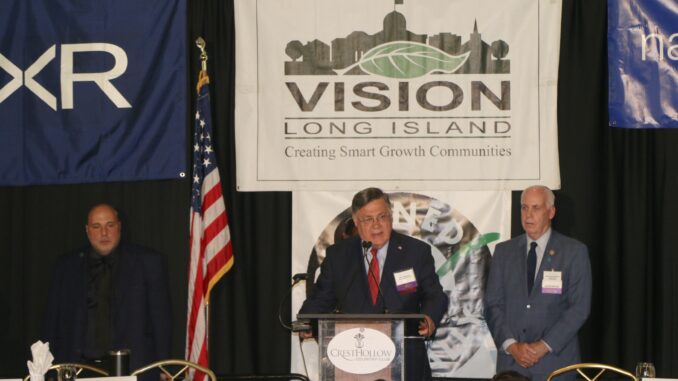
By Hank Russell
Suffolk County Executive Ed Romaine spoke about the need for Long Island to upgrade its infrastructure and expand its network of sewers to improve the environment and the economy during Vision Long Island’s 2025 Smart Growth Awards in Woodbury on June 13.
Romaine and Presiding Officer Kevin McCaffrey (R-Lindenhurst) received the Environmental Leadership Awards during the awards ceremony, which was held at the Crest Hollow Country Club in Woodbury. Both Romaine and McCaffrey spoke about the importance of rebuilding Long Island’s infrastructure and the expansion of sewers throughout the county.
The major problem, Romaine said, is funding. For public transportation, he said, “Nassau County is one-third the size [of Suffolk] but is three times the size, in terms of more money,” the county executive said, adding that Nassau gets $100 million for buses. “That equation needs to change.”
He also pointed out that financial investments in the Island’s infrastructure are crucial when it comes to housing. “You cannot have housing absent infrastructure,” he said.
Long Island Life & Politics spoke with Vision Long Island Executive Director Eric Alexander about the proliferation of housing being built on Long Island and how the attitudes toward new housing have shifted, from “Not in My Backyard” to “Welcome, Neighbor.”
“[These new housing projects] got done because local people planned them,” Alexander said. “They weren’t controlled by some big government; they weren’t controlled by Albany or Washington or even the counties.”
The projects were planned by town and village officials “with input from the civics [civic associations] and the Chambers [of Commerce],” Alexander said. He also noted that “responsible” developers who “don’t overbuild” and who “work with the community, so that’s the formula for success.”
In addition to housing, Alexander said, Long Island also needs energy infrastructure, improvements to road safety and traffic-calming measures on local streets. “It’s not about ‘If you build it, they will come,’ it’s about laying the groundwork for the right types of projects,” he said. That involves lobbying for more money from Albany, “which has always been a challenge.”
As for the money coming from Joe Biden’s infrastructure bill, “until we see that happen,” Romaine said, “we will not see the change that we need. We can build a better Long Island. We can move traffic better, and we can move freight better.” Romaine also stressed the need to utilize rail freight to move products. Right now, the county executive said, only 1% of products are moved by rail freight.
Romaine also spoke about the importance of sewers.He said 70% of Suffolk is unsewered, compared to roughly 10% in Nassau. The new sewers will be paid for through the newly approved one-eighth-percent tax.
“We are going to spend the money wisely,” Romaine said. “We are going to [install] sewers in the downtown area and other areas next year.” He said he plans to spend $1 billion in sewers alone next year, which is “a drop in the bucket.”
McCaffrey said the sewers that are hooked up in Huntington will run downward along the Route 110 corridor into the Southwest Sewer District, which is in McCaffrey’s legislative district. He also noted that the Walt Whitman Mall has been connected to the district “since it existed.”
The Ronkonkoma Hub is also hooked up to the sewer district, according to McCaffrey. There will also be a vote to allow the hamlets of Oakdale and Sayville.
“Everything, as they say, truly flows downhill and, in this case, it really does,” the presiding officer said. “So we got a lot of things to do. We understand the importance of sewers and how it affects not just clean water, but also economic development.”

